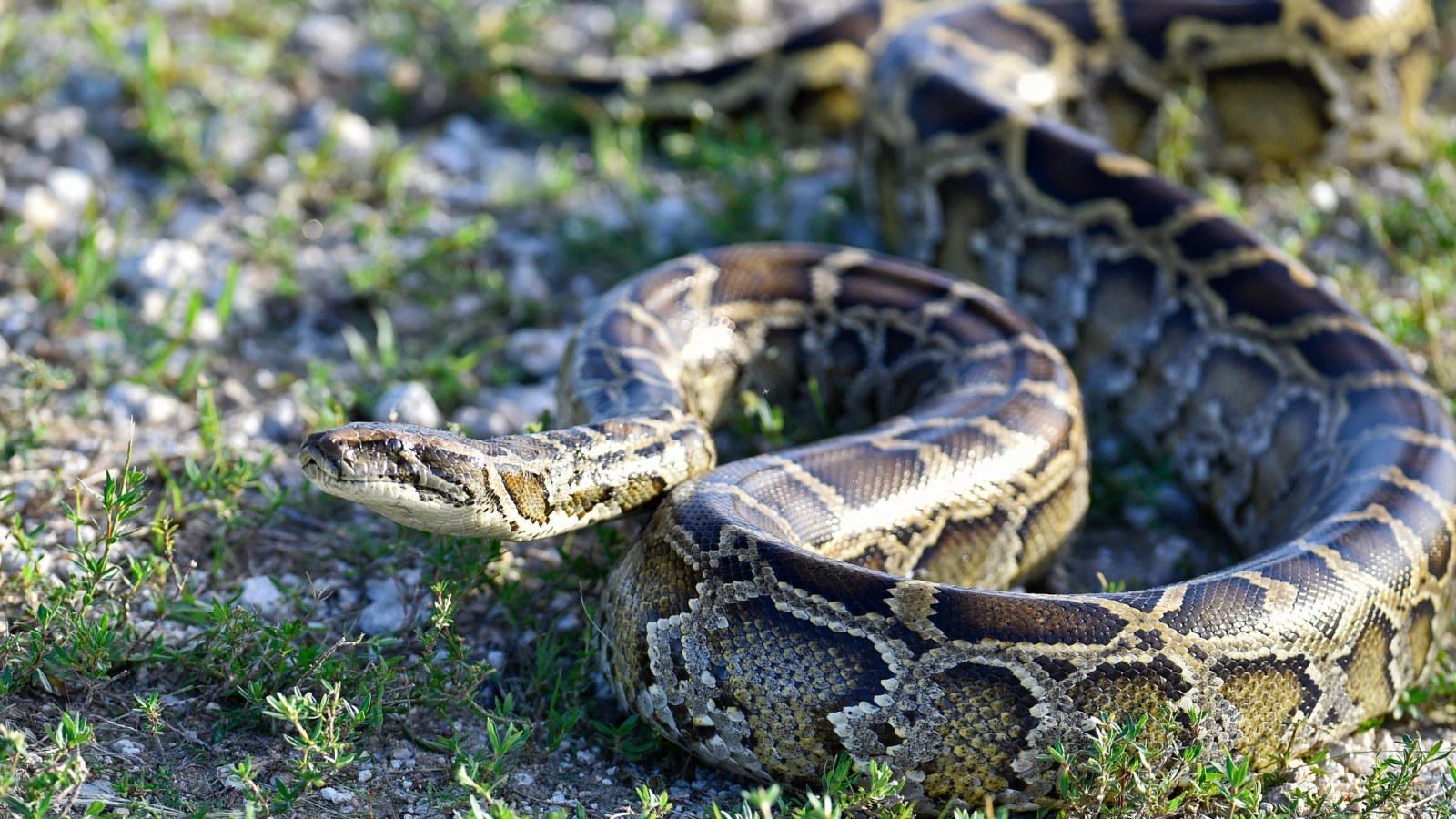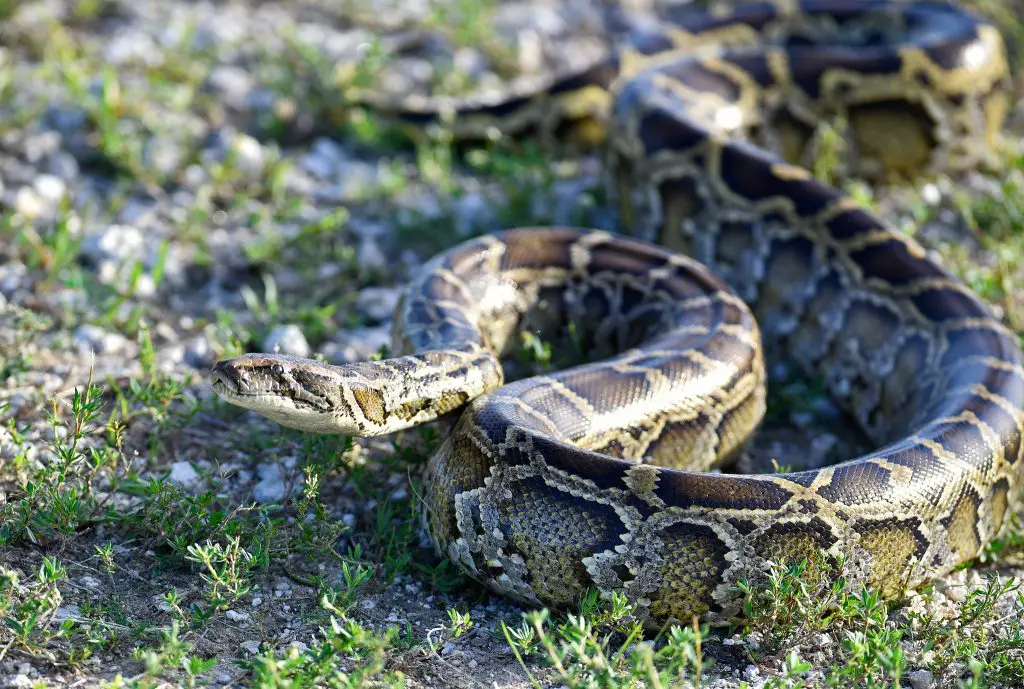Burmese pythons, a non-native species in Florida, have become a major problem in the state. These large constrictors have been wreaking havoc on the local ecosystem, causing a decline in native species and disrupting the natural balance of the Everglades.
The problem with Burmese pythons is not only limited to their impact on the environment, but also poses a threat to public safety. With their ability to grow up to 20 feet long and weigh over 200 pounds, these snakes are capable of attacking and killing humans. It is important to address this issue and find solutions to control their population before it’s too late.
Burmese pythons are an invasive species in the U.S., particularly in the Florida Everglades. They were introduced as pets, but when they grew too large, some owners released them into the wild. These snakes have no natural predators in the area and are causing harm to the ecosystem by preying on native species and disrupting the food chain. They also pose a danger to humans and pets. Efforts to control their population include hunting, capturing, and even the use of trained dogs to detect their presence.

What is the Problem With Burmese Pythons?
Burmese pythons are one of the largest snakes in the world and are native to Southeast Asia. However, these invasive species have become a major problem in Florida and other parts of the United States. The Burmese python population has exploded in the Everglades, and they are causing significant damage to the ecosystem. In this article, we will explore the problem with Burmese pythons and why they are a concern.
Introduction to Burmese Pythons
Burmese pythons are one of the largest snakes in the world, and they can grow up to 20 feet in length and weigh up to 200 pounds. These snakes are native to Southeast Asia and are known for their beautiful coloration and docile nature. However, they have become a major problem in the United States, particularly in Florida.
The Burmese Python Invasion
The Burmese python invasion started in the 1980s when pet owners released them into the wild. These snakes are not native to Florida, and they have no natural predators. As a result, their population has exploded, and they are causing significant damage to the ecosystem.
Environmental Impact
Burmese pythons are wreaking havoc on the ecosystem in the Everglades. They are consuming native wildlife, including birds, mammals, and reptiles. This has caused a significant decline in the population of these animals, which has a ripple effect on the entire ecosystem. The loss of these animals also affects the food chain, which can lead to further damage to the environment.
The Negative Impact on Humans
The Burmese python invasion not only impacts the environment but also poses a threat to humans.
Threats to Humans
Burmese pythons are not venomous, but they are constrictors. They kill their prey by suffocating them and can easily kill humans. While attacks on humans are rare, they do happen, and people have been killed by these snakes.
Impact on the Economy
The Burmese python invasion also has an impact on the economy. The Everglades is a popular tourist destination, and the presence of these snakes can deter tourists from visiting. This can have a significant impact on the local economy, as tourism is a major source of income for many businesses in the area.
Efforts to Control the Population
Efforts are being made to control the population of Burmese pythons in the Everglades.
Hunting and Trapping
One of the ways to control the population of Burmese pythons is through hunting and trapping. The state of Florida has authorized licensed hunters to capture and kill these snakes. The Florida Fish and Wildlife Conservation Commission (FWC) also conducts python removal programs to capture and remove these snakes from the wild.
Research and Education
Research and education are also important in controlling the population of Burmese pythons. Scientists are studying the behavior and habitat of these snakes to better understand how to control their population. Education is also important in preventing the release of pet snakes into the wild and promoting responsible pet ownership.
Conclusion
The Burmese python invasion is a major problem in the United States, particularly in Florida. These invasive species are causing significant damage to the ecosystem and pose a threat to humans. Efforts are being made to control their population, but it will take a collective effort to address this issue. By understanding the problem with Burmese pythons, we can work towards a solution that benefits both the environment and humans.
Frequently Asked Questions
What is the problem with Burmese pythons?
Burmese pythons are non-native species in Florida, and they have become a significant problem for the state’s ecosystem. These large constrictor snakes can grow up to 20 feet long and weigh more than 200 pounds, making them a top predator in the Everglades.
The problem with Burmese pythons is that they are eating their way through the native species in the area. They have no natural predators, and they reproduce quickly, which means their population is growing rapidly. The Burmese pythons are not only killing off the native species, but they are also causing a ripple effect down the food chain, which is impacting the entire ecosystem.
How did the Burmese pythons end up in Florida?
Burmese pythons are not native to Florida, and it is believed that they were introduced into the wild in the 1980s when pet owners released them into the Everglades. The snakes are popular pets, and many people buy them without realizing how large they can grow. When the pythons become too big to handle, some pet owners release them into the wild, which has led to the current problem in Florida.
What is being done to control the Burmese python population?
Efforts are being made to control the Burmese python population in Florida. The state has implemented a program that encourages people to hunt and capture the snakes. There is even a yearly Python Challenge that awards cash prizes to hunters who capture the most snakes. Scientists are also working on developing new methods for controlling the population, such as using a sterilization program to prevent the snakes from reproducing.
Are Burmese pythons dangerous to humans?
Burmese pythons are not considered to be a significant threat to humans. While they are large and can be dangerous if provoked, they are not venomous and are generally not aggressive towards people. However, it is important to remember that these are wild animals and should be treated with caution and respect.
What impact are Burmese pythons having on the ecosystem in Florida?
Burmese pythons are having a significant impact on the ecosystem in Florida. They are killing off native species, which is leading to a decrease in biodiversity. The loss of these species is also impacting the food chain, as many animals rely on them for food. The Burmese pythons are also causing damage to the habitat, as they can destroy vegetation and even alter the water flow in the area. Overall, the presence of Burmese pythons in Florida is having a destructive impact on the ecosystem.
The Burmese Python Problem In The Florida Everglades And Iguana Problem In South Florida
In conclusion, the Burmese python has become a major problem in Florida due to its invasive nature and lack of natural predators. Their ability to thrive in the environment has led to a decline in the population of native species in the region. The python’s rapid reproduction rate and large size have made it difficult for authorities to control their numbers, leading to their spread throughout the state.
Efforts are underway to manage the Burmese python population, including the implementation of hunting programs and the use of technology such as detection dogs and drones. However, more needs to be done to prevent the continued spread of these snakes and protect the natural ecosystem of Florida. It is crucial to raise awareness about the dangers of invasive species and promote responsible pet ownership to prevent the release of non-native animals into the wild.
In conclusion, while the Burmese python may seem like an exciting pet to own, it is important to consider the consequences of releasing them into the wild. The impact of their introduction on the native environment has been devastating and poses a threat to the biodiversity of the region. It is up to individuals, lawmakers, and conservationists to work together to find a solution to this problem and prevent further harm to the ecosystem.


